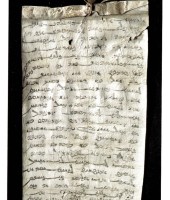Sogdian Documents from Mount Mugh: Historical, archaeological, administrative and economic geographies of Central Asia at the eve of Islamization
Conference by Pavel Lurje, curator at the Hermitage Museum in Saint Petersburg and 2024-2025 research-fellow at the Paris IAS, as part of the Societies, politics and cultures of the Iranian world series (2024-2025) organized by the Centre for Research on the Iranian World (Centre de Recherche sur le Monde iranien - CeRMI).
Onsite event, open to the public without registration.
In English only.
Presentation
It was in 1932-33 that a cash of 80 documents, mostly in Sogdian, but also in Chinese, Arabic and Old Turkic were discovered incidentally in the ruins of the castle on Mount Mugh in the highland part of Tajikistan 150 km east of Samarkand. The documents, as it was shown very soon, are dated to 722 CE (and few decades earlier), and were part of the archive of Dewashtich, the last ruler of Panjakent (the easternmost Sogdian city), and his retinue, who were defeated by Moslem forces and their allies in the mountains. Since 1960s, all the documents became available in facsimiles, photos and transliterations, and in the last decade the updated English translations of the documents were published. The editors of the documents ingeniously identified the majority of the placenames mentioned there, and later the tracks of military expeditions mirrored in the texts were also highlighted. The bulk of the places mentioned are to the east of Samarkand, especially around Panjakent and in the upper Zarafshan valley surrounding mount Mugh, but more distant places are mentioned as well.
Nowadays we possess much better knowledge of archaeological sites of the area (through survey and excavations), of linguistic features of Sogdian, some similar texts have been found elsewhere, and the documents pertaining to another crucial moment in the history of Upper Zarafshan, the Russian conquest of 1860s and its aftermath have been published. These new data permits having a fresh look on the geography of the documents.
The lecturer presents here some results of his research project during his fellowship at the Paris Institute for Advanced Study. Several issues will be addressed: How was the power and administration organized in this area? What were the principal products used and how they were distributed? Which toponyms mentioned in the documents can be associated with the known sites? And what was the oikumene known to the authors of these texts?
|
|
|
The mountain and lowland communities in central Asia: the case of Upper and Lower Zarafshan Valley from Late Antiquity to Early Modernity 01 September 2024 - 30 June 2025 |
|
|

